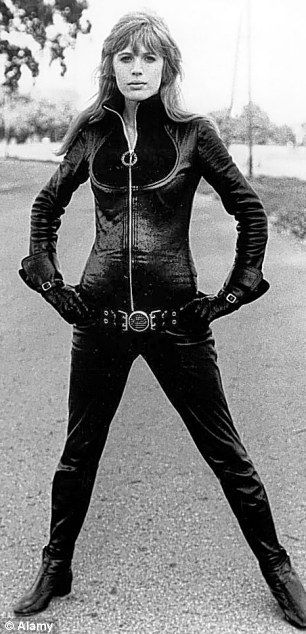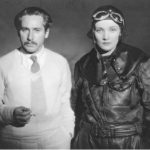The Girl on a Motorcycle, also released as Naked Under Leather, was a 1968 romance/psychedelic film directed by Jack Cardiff and starring Marianne Faithfull. It was the first movie to get an X-rating in the USA.
The framing story is that Rebecca, a young, recently married woman, leaves her husband Raymond in bed, dons her one-piece black leather riding suit (and nothing else), revs up her motorcycle, and rides through France and West Germany to her lover Daniel.

This is interlaced with numerous flashbacks exploring her life, and her relationships with Raymond and Daniel. We see Rebecca’s progression from childishness, living in her father’s bookshop and wearing white fluffy sweaters with her hair up in a bow, to a kind of unstable maturity, cruising through Europe on her motorcycle, naked but for her riding suit, hair blowing in the wind. She’s torn between her sweet but dull husband and her passionate lover.
There are echoes of Belle De Jour (1967), also about a woman between a husband who is too nice and a harsher but passionate lover. There are important differences that demonstrate very different attitudes to women and their sexuailty. Belle Du Jour is tense and claustrophobic; Severine’s scenes are, except for her fantasies, mostly indoors, either her home or the brothel, either wife or whore, the only alternatives.
Rebecca stops on her journey in a cafe and writes two notes, one telling Daniel she can’t do this anymore, the other telling Raymond she’s leaving him. Then she crumples up both notes and throws them away. She’s hung up on a false dilemma, unable to conceive of an alternative when it is right in front of her.

Girl shows Rebecca delighting in riding all on her own, with the open landscapes suggesting infinite possibilities. Daniel has given her freedom, in the form of the motorcycle he gave her as a wedding present. She doesn’t have to ride it to Daniel’s house. She could go anywhere. The sexual connotations are there too. Daniel has awakened Rebecca’s sexuality, but unlike Severine’s brutish lover in Belle De Jour, he’s not possessive. If Rebecca chooses to end the affair and devote herself to her husband, he respects her decision.
Without a doubt, the primary image of this film is Marianne Faithfull in her riding suit. Diana Rigg probably did the most to bring form-fitting black leather into female fashion as Emma Peel in The Avengers, but Faithfull is a close second. Like the black bodysuits worn by Josette Andriot in Protea and Musidora in Les Vampires, and Diana Rigg, Rebecca’s suit represents not only physical pleasure and freedom, but freedom from prescribed social roles, a space between “child” and “mother”.
Note that while Daniel bought Rebecca the motorcycle, there’s no mention of how she got the suit. Presumably she bought it for herself. Even before she gets the suit, she’s often shown wearing brown leather or suede.
The flip side of Rebecca’s freedom is her vulnerability. She also has fantasies of her riding suit being ripped from her body, leaving her naked before onlookers. The suit is the only thing between her and the world. The men who admire her black-clad body throughout the movie are both flattering and threatening.
Also like Belle Du Jour, the film ends in tragedy. Having had a couple of drinks and riding without her helmet, she gets into a road accident and collides with a truck. The last we see of her is her body thrown headfirst through the windshield of an oncoming car, a grotesque end for a woman who seemed so full of life.
Marianne Faithfull later appeared in Kenneth Anger’s short film Lucifer Rising (1972), as Lilith. Anger had earlier made underground gay leather/fetish films Fireworks and Scorpio Rising.
The film was adapted from a novel by French writer André Pieyre de Mandiargues, The Motorcycle (1963). De Mandiargues also wrote an introduction to Story of O, and likely based the book’s protagonist on female motorcycle journalist and racer Anke-Eve Goldmann. Goldmann was the first woman to ride a motorcycle in a one-piece leather racing suit, made by German manufacturer Harro.
Jack Cardiff directed a few other films, and was better known as a celebrated cinematographer, with a career that reached from the 1930s to the 2000s and included classics like The African Queen and The Red Shoes.
Rebecca’s stream of consciousness voiceovers were written by Gillian Freeman, who also wrote the 1961 novel The Leather Boys and the screenplay for the 1964 film adaptation, which concerned British gay identity and biker culture.



